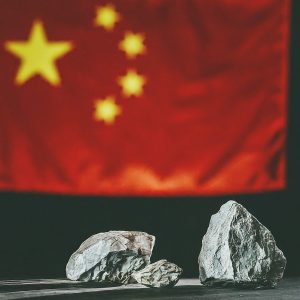Concerns continue apace about the meaning of China stockpiling minerals. In addition to China’s government statements and military activities, stockpiling minerals is one potential indicator that China may be preparing for a military invasion of Taiwan. China’s National Food and Strategic Reserves Administration (NFSRA) – previously known as the State Reserve Bureau (SRB) – manages China’s mineral stockpile, which contains minerals ranging from gallium and germanium to tantalum and tungsten.
While China is not exceedingly secretive about stockpiling “non-strategic” minerals in which China has ample domestic production, like aluminum, it is secretive in stockpiling “strategic” minerals like copper, in which its domestic demand exceeds domestic production. Given China’s general secrecy, how can we monitor its stockpiling?
Broadly, five stockpiling indicators can be observed: direct stockpiling, government tenders, leaked information, industry reports, and evidence of other market indicators like spiking imports.
Direct stockpiling is, as the name suggests, the easiest to track. For example, in 2012–2013, the SRB publicly bought 400,000 metric tons of aluminum and 145,000 metric tons of zinc. Such direct stockpiling is most evident when China wants to send price signals to the market and with non-strategic minerals like zinc.
The second indicator of stockpiling is when the NFSRA publishes a tender. Before undertaking purchases of non-strategic minerals for its stockpile, the NFSRA occasionally publishes a public tender, sending a price signal and helping increase the mineral’s price. In 2012, for example, the SRB publicly published a tender to purchase 160,000 metric tons of aluminum from Chinese smelters. Sometimes, the NFSRA does not proceed with purchasing minerals for the stockpile.
Third, industry or government sources in China sometimes disclose information on discussions between the NFSRA and Chinese producers regarding stockpiling. To illustrate, a Reuters article in May 2024 reported that the NFSRA was seeking to buy 15,000 metric tons of cobalt, and the report was based on information from industry sources. Industry sources may also leak details concerning a “closed-door” tender, which invites a select group of firms to submit bids. The state-backed Chinese metal research firm Antaike sometimes advises the NFSRA on stockpiling, and it may disclose stockpiling information too.
Fourth, industry analysts, news agencies, and price reporting agencies may detect stockpiling by tracking market data and industry sources. For instance, Citi Bank closely follows China’s stockpile purchases and sales. News agencies like Reuters and Bloomberg and price reporting agencies like Fastmarkets and Benchmark Mineral Intelligence also track China’s stockpiling activities.
Finally, stockpiling can be evidenced by other market indicators like spiking imports. Market data other than explicit stockpile purchases can sometimes indicate stockpiling. According to Reuters, the SRB stockpiled copper largely via imports from 2010 to 2015. In 2022, Reuters speculated that China’s accelerating copper imports in 2022 could be the SRB importing copper for its stockpile.
Importantly, mineral stockpiling alone is not indicative of China preparing to invade Taiwan. Stockpiling could be occurring for non-military reasons, either strategic or economic. Strategically, China could be stockpiling for non-military purposes, like copper supply concerns during the COVID-19 pandemic. Alternatively, China could be stockpiling for economic reasons, such as increasing mineral prices to support domestic mineral producers.
However, discerning when China is stockpiling and its reasons for doing so is increasingly challenging given China’s increasing secrecy about mineral-related information. Concerningly, countries sometimes restrict the disclosure of mineral-related information before initiating conflict. For example, Germany stopped publishing its metal consumption figures in 1935, which coincided with Germany beginning to rapidly stockpile minerals. Germany later invaded Poland in September 1939.
To assess China’s mineral stockpiling activities amid increased secrecy, accessing sources in China’s NFSRA, Ministry of Natural Resources, and National Development and Reform Commission, which oversees the NFSRA, could prove particularly helpful. Other potential sources with valuable information could be individuals in state-owned mineral companies that coordinate with the Chinese central government on mineral stockpiling, like Baotou Steel, which assists with storing rare earth elements. Monitoring shipments to and from government facilities storing minerals could also help detect increased stockpiling.
Ultimately, mineral stockpiling is just one indicator that China may be preparing for a military invasion of Taiwan. Still, it should be monitored given the historical precedent of states stockpiling minerals before invasions, such as Germany and Japan before World War II. To better understand its military implications, China’s mineral stockpiling should be contextualized by China’s government statements and military activities concerning Taiwan.

































